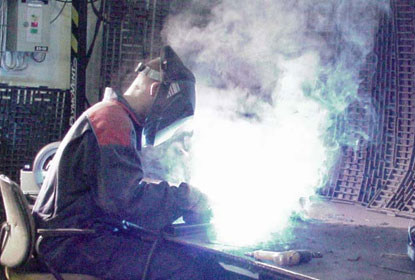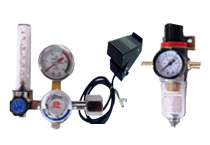
Welding Diseases and Hazards
Welding Introduction
The process of Welding is a human activity which is technical in scope and mechanical in execution. It is widely practiced in many areas of manufacturing, installation, repair, and maintenance throughout many infrastructures.
Many branches of engineering depend of welding:
- civil
- electrical
- mechanical
- automobile
- marine
- aeronautical
In fact, the process of building and maintaining a nation is often dependent on the basic function of welding. Whether you are considering smaller turnkey projects or large scale, cutting-edge fabrication, welding is a likely requirement. However for all of its positive benefits, Welding can have some potential negative factors also. Specifically, these negative factors are often related to the person operating welding equipment in the form of health and safety risks.
Welder Operators
Many Welders are likely to be exposed to certain health hazards. This applies to both the professional and those who weld on an occasional basis as well. By virtue of their being exposed to the welding process for extended periods of time, they may be afflicted with a variety of ailments. According to the National Institute for Occupational Safety and Health (NIOSH), as many as 400,000 Americans are employed in the welding and associated professions.
![]()
Scientific studies reveal that these workers are at risk of serious respiratory, neurological, reproductive and digestive problems. In 2003, NIOSH published a revealing report titled "Health Effects of Welding". It informs us that past investigations have found bronchitis, airway irritation and other respiratory illnesses in large numbers of welders. Welding fumes may create risks of lung cancer and damage the nervous system. Such fumes may contain nickel, chromium and manganese. Nickel and hexavalent chromium are defined as potential occupational carcinogens. Furthermore, chronic exposure to manganese may cause ailments like Parkinson's disease.
NIOSH has identified two complimentary types of research.
- A continuation of epidemiological studies to offer a thorough understanding about the root cause of immune suppression, lung cancer development, neurotoxicity, skin damage, reproductive disorders, etc,.
- Toxicology investigations to examine important biochemical reactions to welding fumes, at the molecular level in lab experiments.

The American Federation of State, County and Municipal Employees (AFSCME) has presented a welding hazards fact sheet which provides information about diseases caused by
- welding
- brazing
- soldering
- metal cutting
As per this report welding smoke is a mixture of very fine particles (fumes) and gases. They contain chromium, nickel, arsenic, asbestos, manganese, cadmium, etc., all of which are extremely toxic and may be potentially life-threatening. Generally, fumes and gases emerge from the base material or filler substance. These may be from paints and coatings on the metal or material covering the electrodes, shielding gases, chemical reactions from the arc, ultraviolet light and heat, or other processes/consumables, and contaminants.
Welding Diseases
Welding smoke can irritate the eyes, nose, chest and respiratory tract. It can also cause bronchitis, pulmonary edema,pneumonitis, gastro intestinal effects such as nausea, appetite loss, vomiting, cramps, slow digestion, etc.
Short term reactions include:
- metal fume fever
- chills
- thirst
- muscle ache
- normal fever
- chest soreness
- coughing
- wheezing
- fatigue
- nausea
- a metallic taste in the mouth

Welders run the risk of contracting lung cancer, possible larynx and urinary tract cancer. They may have chronic respiratory problems such as asthma, pneumonia, emphysema, silicosis, and siderosis. Other related problems are heart disease, skin ailments, hearing loss, chronic gastritis, gastroduodenitis, and intestine ulcers. Also, welders who smoke may have higher chances of health damage than those abstain from smoking.
Welding fumes and gases damage the reproductive system also. They create asbestos related-diseases. All such risks are more predominant in the case of welders working in restricted areas. Recent research has confirmed a link between welding fumes and Parkinson's disease, a neurodegenerative affliction which damages mental and physical ability. Some patients report impaired reflexes, gait disturbances, the loss of balance and mobility problems. They prompt depression, sleep disturbances, dizziness, stooped postures, constipation, dementia, speech disorders, breathing, swallowing and reproductive malfunctions. They lead to decreased motor skills, failing intellectual capacity, increased tremors, memory loss.
Cadmium in welding fumes can be fatal even in short term exposure. Ultra violet radiation caused by welding reacts with oxygen and nitrogen available in the air forming ozone and nitrogen oxides. They lead to irritation of nose and throat and may cause serious lung diseases which may be fatal. Ultraviolet rays can react with chlorinated hydrocarbon solvents such as trichloroethylene to form phosgene gas which may be deadly, even in small quantities.
All such risks are more predominant in the case of welders working in areas without proper ventilation. These hazards depend on the type of materials to be welded. The welder should obtain a Material Safety Data Sheet (MSDS) for these. The welder must also consider the environmental conditions in which the welding process is to be conducted. After identifying such hazards, it is the welder's responsibility to ensure that proper control methods are followed.
Here are some basic considerations:
- Use cadmium-free silver solders and asbestos-free electrodes
- Wear proper protective clothing like gloves and hot pads
- Adopt adequate ventilation
- Local exhaust ventilation is the most adequate method.
- Use hoods to cover the face
- Clean and maintain ventilation systems regularly.
- Periodic inspection is mandatory.
- General ventilation and local ventilation - both will reduce the health hazards.






